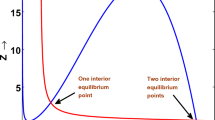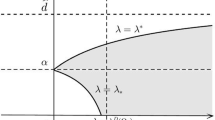Abstract
We propose a general almost periodic model to describe a mutualistic interaction between two seasonal species when climate-mediated shifts change their population dynamics. In the modeling process, we use almost periodic functions as parameters of the model to describe a loss of synchronicity in the population dynamics of the mutualistic species. We also consider that the benefit granted for each species from the interaction with the partner species is modeled by a family of increasing bounded functions, which describe the fact that the maximum benefit received for each species is reached in high abundance of the partner species. We prove that there is a unique almost periodic globally stable solution of the model, when some conditions over the parameters of the model proposed are satisfied. Numerical simulations of the solutions of the model show significant differences between solutions within the periodic and the almost periodic framework. Forecasting asynchronous arrivals of species can help to decision makers to design species conservation strategies.



Similar content being viewed by others
References
Hernandez, J.M., Barradas, I.: Variation in the outcome of population interactions: bifurcations and catastrophes. J. Math. Biol. 46, 571–594 (2003)
Hale, K.R.S., Valdovinos, F.S.: Ecological theory of mutualism: Robust patterns of stability and thresholds in two-species population models. Ecol. Evolut. 11, 17651–17671 (2021)
Lin, S., Zhou, Q., Wu, R.: Positive periodic solution of a discrete commensal symbiosis model with beddington-deangelis functional response. J. Math. Computer Sci. 28, 363–372 (2023)
Wolin, C.L., Lawlor, L.R.: Models of facultative mutualism: density effects. Am. Nat. 124, 843–862 (1984)
Addicott, J.F.: A multispecies aphid-ant association: density dependence and species-specific effects. Can. J. Zool. 57, 558–569 (1979)
Anderson, A.C., James, A.R.M., Magno, E., Geber, M.: Bee species exhibit different phenological trajectories in communities of annual flowering plants in the genus clarkia. Clim. Change Ecol. 2, 100031 (2021)
Prior, K.M., Palmer, T.M.: Economy of scale: third partner strengthens a keystone ant-plant mutualism. Ecology 99, 335–346 (2018)
Palmer, T.M., Brody, A.K.: Enough is enough: the effects of symbiotic ant abundance on herbivory, growth, and reproduction in an african acacia. Ecology 94, 683–691 (2013)
Calixto, E.S., Novaes, L.R., Santos, D.F.B., Lange, D., Moreira, X., Del Claro, K.: Climate seasonality drives ant-plant-herbivore interactions via plant phenology in an extrafloral nectary-bearing plant community. J. Ecol. 109, 639–651 (2020)
Maglianesi, M.A., Hanson, P., Brenes, E., Benadi, G., Schleuning, M., Dalsgaard, B.: High levels of phenological asynchrony between specialized pollinators and plants with short flowering phases. Ecology 101, e03162 (2020)
Cushing, D.H.: The regularity of the spawning season of some fishes. ICES J. Marine Sci. 33, 81–92 (1969)
Durant, J.M., Hjermann, D.O., Stenseth, N.C.: Climate and the match or mismatch between predator requirements and resource availability. Clim. Res. 33, 271–283 (2007)
Visser, M.E., Gienapp, P.: Evolutionary and demographic consequences of phenological mismatches. Nat. Ecol. Evol. 3, 879–885 (2019)
Kharouba, H.M., Ehrlén, J., Gelman, A., Bolmgren, K., Allen, J.M., Travers, S.E., Wolkovich, E.M.: Global shifts in the phenological synchrony of species interactions over recent decades. PNAS 115, 5211–5216 (2018)
Damien, M., Tougeron, K.: Prey-predator phenological mismatch under climate change. Current Opin. Insect Sci. 35, 60–68 (2019)
Both, C., van Asch, M., Bijlsma, R.G., van den Burg, A., Visser, M.: Climate change and unequal phenological changes across four trophic levels: constraints or adaptations? J. Animal Ecol. 78, 73–83 (2009)
McKinney, A.M., CaraDonna, P.J., Inouye, D.W., Barr, B., Bertelsen, C.D., Waser, N.M.: Asynchronous changes in phenology of migrating broad-tailed hummingbirds and their early-season nectar resources. Ecology 93, 1987–1993 (2012)
Stenseth, N.C., Durant, J.M., Fowler, M.S., Matthysen, E., Adriaensen, F., Jonzén, N., Chan, K.S., Liu, H., Laet, J.D., Sheldon, B.C., Visser, M.E., Dhondt, A.A.: Testing for effects of climate change on competitive relationships and coexistence between two bird species. Proc. R. Soc. B. 282, 20141958 (2015)
Rafferty, N.E., CaraDonna, P.J., Bronstein, J.L.: Phenological shifts and the fate of mutualisms. Oikos 124, 14–21 (2015)
Olliff-Yang, R.L., Mesler, M.R.: The potential for phenological mismatch between a perennial herb and its ground-nesting bee pollinator. AoB Plants 10, ply040 (2018)
Altizer, S., Dobson, A., Hosseini, P., Hudson, P., Pascual, M., Pejman, R.: Seasonality and the dynamics of infectious diseases. Ecol. Lett. 9, 467–484 (2006)
Dumont, Y., Thulliez, J.: Human behaviors: a threat to mosquito control? Mathemat. Biosci. 281, 9–23 (2016)
Dembele, B., Friedman, A., Yakubu, A.A.: Malaria model with periodic mosquito birth and death rates. J. Biolog. Dynam. 3, 430–445 (2009)
Eikenberry, S.E., Gummel, A.B.: Mathematical modeling of climate change and malaria transmission dynamics: a historical review. Mathemat. Biol. 77, 857–933 (2018)
Wang, B.G., Qiang, L., Wang, Z.C.: An almost periodic ross-macdonald model with structured vector population in a patchy environment. J. Math. Biol. 80, 835–863 (2019)
Qiang, L., Wang, B.G.: An almost periodic Malaria transmission model with time delayed input of vector. Discrete Continuous Dynam Syst Series B 22, 1525–1546 (2017)
Díaz-Marín, H.G., López-Hernández, F., Osuna, O.: Almost periodic solutions for seasonal cooperative systems. Annal. Polonici Mathematici 128, 1–14 (2022)
Wang, B.G., Zhao, X.Q.: Basic reproduction ratios for almost periodic compartmental epidemic models. J. Dyn. Diff. Equat. 25, 535–562 (2013)
Bohr, H.: Almost Periodic Funct. Chelsea Publishing Company, New York (1947)
Wright, D.H.: A simple, stable model of mutualism incorporating handling. Am. Nat. 134, 664–667 (1989)
Graves, W., Peckham, B., Pastor, J.: A bifurcation analysis of a differential equations model for mutualism. Bull. Math. Biol. 68, 1851–1872 (2006)
Corduneanu, C.: Almost Periodic Funct. Chelsea Publishing Company, New York (1989)
Smith, H.L.: Monotone dynamical systems: an introduction to the theory of competitive and cooperative systems. AMS, Tempe (1995)
Hirsch, M.W.: Systems of differential equations that are competitive or cooperative ii: Convergence almost everywhere. SIAM J. Mathemati. Anal. 16, 423–439 (1985)
Wu, R., Li, L.: Note on the stability property of the boundary equilibrium of a may cooperative system with strong and weak cooperative partners. J. Math. Comp. Sci. 20, 58–63 (2020)
Acknowledgements
The authors would like to thank the editor and two anonymous referees who kindly reviewed this work and provided valuable suggestions concerning the manuscript.
Author information
Authors and Affiliations
Corresponding author
Additional information
Publisher's Note
Springer Nature remains neutral with regard to jurisdictional claims in published maps and institutional affiliations.
Appendix A: Almost Periodic Functions and Cooperative Systems
Appendix A: Almost Periodic Functions and Cooperative Systems
In this first part, we summarize some well known basic facts about the almost periodic functions and cooperative systems. Almost periodic functions are nowadays a very active theme. We give here only a very basic introduction to the topic and refer the reader to [29, 32] for much more details.
Definition 1
A function \(\phi \in \textrm{C}^0(\mathbb {R})\) is almost periodic if, for all \(\epsilon >0\) there exists a set of real numbers \(T(\epsilon )\subseteq \mathbb {R}\) altogether with a length \(l(\epsilon )>0\) such that for any interval of length \(l(\epsilon )\), there exists at least one point \(\tau \in T(\epsilon )\) contained in that interval such that
for each \(x\in \mathbb {R}\). We will call numbers in \(T(\epsilon )\) translation numbers and the number \(l(\epsilon )\)will be called a length for \(T(\epsilon )\).
The above collection of all almost periodic functions will be denoted by \(AP(\mathbb {R})\) which is a Banach space endowed with the usual \(\sup -\)norm. It is possible to associate to an almost periodic function \(\varphi\) its unique Fourier series:
The exponents \(\lambda _n\) are called the frequencies of \(\phi\).
Typical examples of almost periodic functions are \(\sin t+\sin \sqrt{2}t\) which is almost periodic since it is a trigonometric polynomial presents a finite number of Fourier frequencies. Another example which is not quasi periodic is for instance \(\sum _{k=1}^\infty \frac{1}{k^2}\cos \frac{t}{k^2}\).
Another well-known result in this area is that, for every almost periodic function there exists the mean value
This is a bounded linear functional, \(\mathcal {M}:AP(\mathbb {R}) \rightarrow \mathbb {R}\), having the following properties:
-
1.
\(\phi \ge 0\) implies \(\mathcal {M}[\phi ]\ge 0\).
-
2.
The Parseval equality holds:
$$\begin{aligned} \mathcal {M}\left[ \left| \phi \right| ^2\right] = \sum _{n\in \mathbb {N}} \left| a(\lambda _n)\right| ^2. \end{aligned}$$
Now we review some aspects about cooperative systems, for a brief introduction to cooperative systems see [33]. For two points \(x, y \in \mathbb {R}^2\) denote the partial order \(u \le v \; \text {if}\; u_i \le v_i \; \text {for each} \; i\), also denote \(u<v\) if \(u\le v\) and \(u\ne v\). Let \(f,g:\mathbb {R}\times D\subseteq \mathbb {R}^3\rightarrow \mathbb {R}\) be a couple of differentiable and almost periodic functions on the first variable. We consider the system:
where we suppose that f(t, x, y), g(t, x, y) are both uniformly almost periodic with respect to \((x,y)\in C\) for every compact \(C\subseteq D\), i.e., the set of translation numbers, \(\tau (\epsilon )\), is independent of \((x,y)\in C\).
More specifically, if f have generalized Fourier expansions,
f is uniformly almost periodic, whenever the frequencies \(\lambda _n\) do not depend on (x, y), see [32] Chapter VI.
Definition 2
System (A1) is said to be of cooperative type if for all \(t\in \mathbb {R}\), \(x\in (a(t),A(t))\), \(y\in (b(t),B(t))\) we have
We will say that (a(t), b(t)) are a subsolution pair if
For every \(t\in \mathbb {R}\). A super-solution (A(t), B(t)) is defined similarly with the reversing inequalities. We will say that a sub-solution (a(t), b(t)) and a supersolution (A(t), B(t)) are ordered if \(a(t)\le A(t)\) and \(b(t)\le B(t)\) for all \(t\in \mathbb {R}\).
A cooperative system is a monotone dynamical system in the sense that the Poincare map preserves a partial ordering on \(R^{n}\). When \(n=2\), every solution of (A1) is eventually monotone. Typically in this type of systems, the solutions converge asymptotically to equilibrium [34, 35]. An important feature for cooperative system (A1) related to almost periodic orbits was established in [27], Theorem 2. Explicitly the following result holds.
Theorem 2
Consider an ordered pair of a subsolution pair (a(t), b(t)) and a supersolution pair (A(t), B(t)) of the system (A1) such that \(a(t)<A(t),\) and \(b(t)<B(t)\). Suppose that there is no equilibrium point \((x_0,y_0)\) such that \(a(t)\le x_0\le A(t)\) and \(b(t)\le y_0\le B(t)\). If the system is cooperative type, then it has an almost periodic solution satisfying \(a(t)\le x(t)\le A(t)\) and \(b(t)\le x(t)\le B(t)\) for all \(t\in \mathbb {R}\). Furthermore, if \((\underline{x}(t),\underline{y}(t)),({\overline{x}}(t),{\overline{y}}(t))\), denote the minimal and maximal almost periodic solutions having initial data satisfying \(a(0)<x(0)<A(0)\) and \(b(0)<y(0)<B(0)\). Then any solution of (A1), converges to the product of strips \((\underline{x}(t),{\overline{x}}(t))\times (\underline{y}(t),{\overline{y}}(t))\).
In a degenerate case, we could have a stable equilibrium, instead of a genuine almost periodic orbit.
Rights and permissions
Springer Nature or its licensor (e.g. a society or other partner) holds exclusive rights to this article under a publishing agreement with the author(s) or other rightsholder(s); author self-archiving of the accepted manuscript version of this article is solely governed by the terms of such publishing agreement and applicable law.
About this article
Cite this article
Díaz-Marín, H.G., Guerrero-Flores, S., Osuna, O. et al. A Class of Mutualistic Systems Having an Almost Periodic Global Attractor. Differ Equ Dyn Syst (2023). https://doi.org/10.1007/s12591-023-00639-w
Accepted:
Published:
DOI: https://doi.org/10.1007/s12591-023-00639-w




